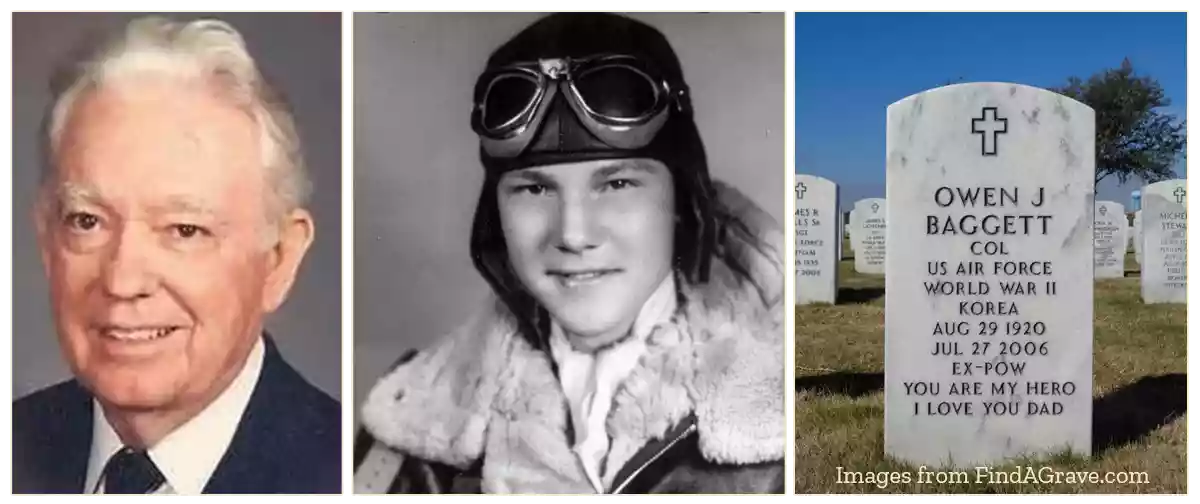
WWII soldier who shot down a plane with a pistol: Never underestimate an armed Texan from Young County!
COL Owen John Baggett
In a late Veterans Day tribute to our native Young County Veterans, we proudly present the legend and history of WWII Colonel Owen John Baggett. Owen John Baggett was born in August 29,1920 in Graham, Texas to John and Mary Pearl Owen Baggett.
In Young County, you generally find two types of native citizens: Those who move away as fast as they can, or those who never really leave. Owen Baggett appears to have had the wanderlust of the first category.
After graduating high school in 1938, Owen, who was reported in several accounts to have been remembered by the citizens of Graham for his quick smile and kind words, attended Hardin Simmons University and served in the band as its Drum Major, graduating in 1941.
He took his degree to New York, where he was soon employed as a Defense Contractor, working in an office on Wall Street.
After the onset of World War II, Owen enlisted in the Army Air Force and was accepted on July 26, 1942, and attended New Columbus Army Flying School. Baggett graduated with the rank of 2nd Lieutenant and was assigned to the 7th Army Bomber wing, stationed in the Pacific Theater in British East India.
Baggett was assigned to fly the American Consolidated B-24 “Liberator” Bomber, a predecessor of the B-17 “Flying Fortress”. The B-24 had been designed with what was considered a highly efficient shoulder mounted, high on the airframe “Davis Wing”. The wing made for more efficient flight at high speeds and altitudes which increased its range, but the wing also put a lot of weight on the plane that often caused catastrophic damage to the airframe when crashing. The plane was also reported to be notorious among pilots for its tendency to catch fire.
There is only one intact B-24 left in the world today and is owned and operated by the Collins Foundation. Because of the long range of many of the B-24 bombers, they would often be forced to fly without friendly fighter escorts, leaving them as easy prey of enemy fighters, such as the Japanese Zero, one of the finest fighters of the day.
As if this wasn’t enough of a danger to American plane crews, the Japanese had adopted a policy of shooting plane crews when they parachuted out of their aircraft to keep them from being rescued and returned to flying attack missions.
On March 31, 1943 Baggett’s squadron was ordered to destroy a bridge at Pyinmana in Burma.
The bridge was an important supply line for the Japanese and as such, was heavily fortified by anti-aircraft emplacements and fighter air patrols. Enroute to their target, the bomber squadron was soon intercepted by 13 Ki-43 fighters of the 64th Sentai Imperial Army Air Force. Almost immediately, Baggett’s plane was hit, and several rounds punctured the aircrafts fuel tanks, with the plane catching fire.
The plane was severely damaged, on fire and losing altitude so Baggett and the crew made the decision to abandon the plane, each taking their turn stepping out of the aircraft and into the sky. Baggett had already been wounded before bailing out, and attempting to play dead, watched two of his crewmates die from strafing gunfire by Japanese fighters as they floated helpless in their harnesses.
WWII pilots and crews were issued 1911 45 caliber semiautomatic pistols, a design that had been patented during WWI, hence the name 1911. As he drifted towards the ground, he observed one of the fighters break off from the attacks, and slow to do a flyby to see if he was in fact dead. As the pilot closed the distance, Owen observed him open his canopy to get a better view.
Seizing the opportunity, Owens drew his pistol and fired four shots in quick succession into the enemy cockpit. Accounts differed at the time, as there were reports that the enemy aircraft spiraled out of the sky to crash and the body of the pilot found in the wreckage with a bullet hole in the skull, to the “official Japanese air report” that no planes were lost, however this report, was suspect as both sides practiced giving misinformation during the war.
Baggett was captured immediately upon landing and remained a prisoner of war for two and a half years, before being rescued along with 37 other POW’s in a daring rescue by eight OSS agents. Upon his return he learned that he had become famous for being the only person in WWII to shoot down an enemy plane with a handgun. The feat had been witnessed by Colonel Harry Melton whose fighters had been assigned their escort that day. Melton could confirm that he witnessed the shot and saw the enemy plane crash. Baggett acknowledged publicly that he was grateful that his life had been spared, and returned to the service, retiring with full honors as a Colonel in 1973 at the age of 53.
Baggett was a true servant and was recognized for work with children. He sponsored both a boy and a girl through the Army Air Force’s Commander for a Day program.
After leaving the Air Force, he went back to work as a defense contractor manager. His life of service ended with peace and dignity when he died at his home in New Braunfels, Texas on July 27, 2006.
It is the duty of historians to report the valor and honor of those who go before us, and we hope that those who served will record their memories for the children of the future, to learn what was important to them, what they experienced, and what they learned and how that experience affected the person they became.
As always, we proudly honor our Veterans who defend and protect our way of life every day. May God bless and protect all who serve and have served.

